Product Design
Adventure Down Hidden Depths
A Gamified ADHD Coaching Tool for Young Adults
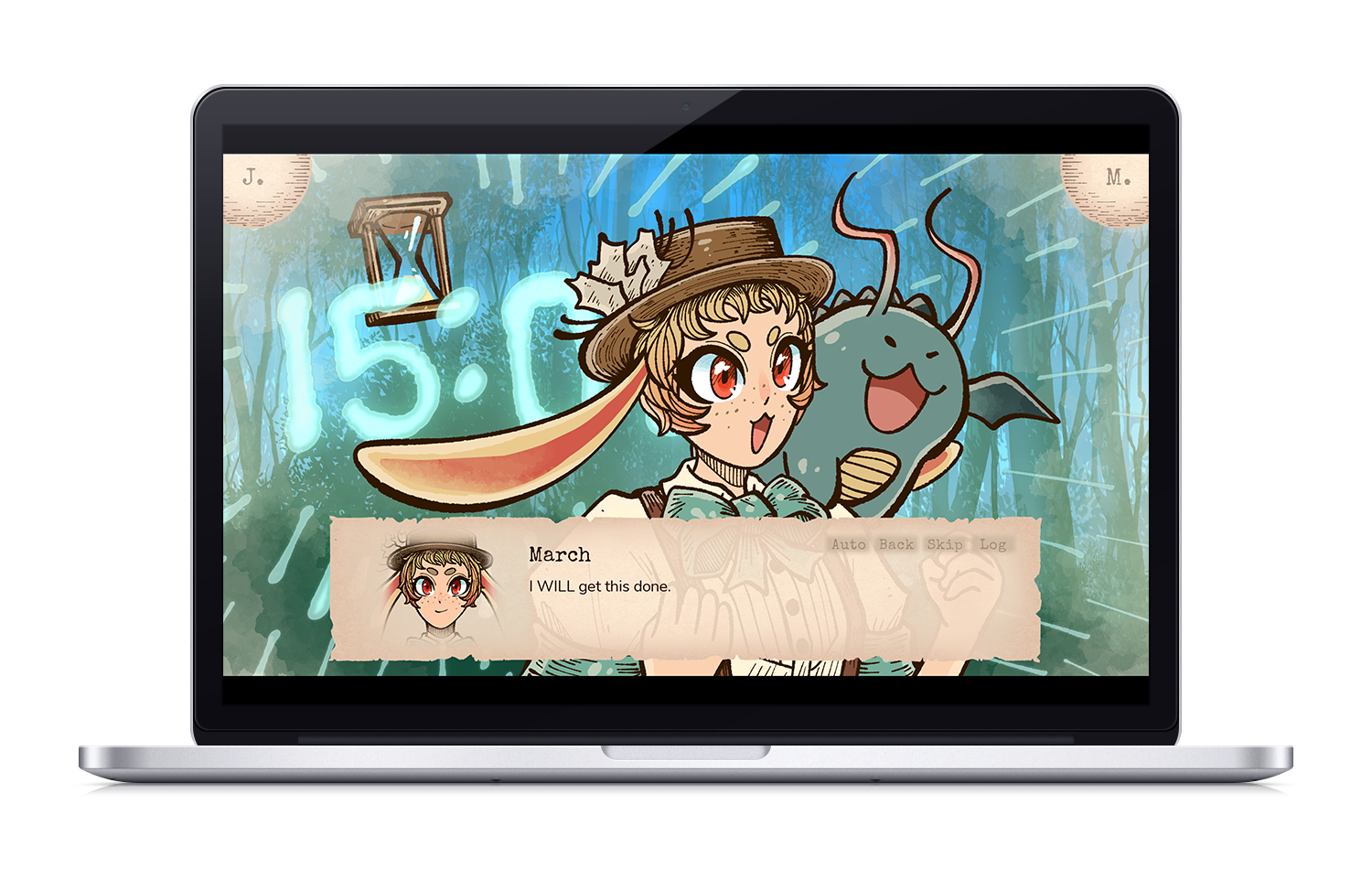

Awarded the 2021
Vesalian Scholar Research Grant
For exceptional merit in project design, concept, and production plan.
Project Type
Academic
Master's research project
Duration
April 2020 - Ongoing
Audience
Young adults with ADHD
My Roles
Project manager
Product designer
Scriptwriter
Artist
Programmer
Content researcher
Team
Supervisory Committee
Dr. Shelley Wall, PhD
MScBMC, University of Toronto
Dr. Derek Ng, PhD
MScBMC, Univeristy of Toronto
Content Expert
Dr. Nicole Koziel, MD, FRCPC
Women's College Hospital
Assistant Lecturer, University of Toronto
Introduction
For many young adults, it's the first time in their life where they begin to experience an
independent
lifestyle. The shift from the structure of daily schoolwork to long-term life and career
obligations
can
be jarring. Young adults with attention deficit hyperactivity disorder (ADHD) may find
themselves
most at a loss during this transitory point in their lives.
Adventure Down Hidden Depths (AdventDHD) is a gamified self-directed ADHD coaching tool
tailored
for
young adults with ADHD. Using the visual novel medium, AdventDHD is a digital
interactive
“choose your own adventure” game that creates a uniquely engaging e-learning experience.
You wake up to find yourself as the Chosen One in a fantasy Wonderland, covered by a
cursed
fog.
Wonderland is home to the brightest wizards around, except... They have their own work
piled
up.
To make your way home, venture around with the White Rabbit guide and help the people of
Wonderland
sort out their daily struggles amongst the fog.
Maybe you'll
learn
something
along the way, too?
Problem
ADHD is a common psychiatric disorder estimated to affect 4% of US adults. Symptoms can affect a
person's
memory, time perception, and thought processes. However, despite the high impacts on
relationships,
mental health, finances, and more, adult ADHD often goes underdiagnosed—and
undertreated.
Traditional ADHD coaching can be inaccessible to many young adults for a variety of
reasons:
- Courses are expensive and barred by location, timing, or insurance.
- Continued attendance is a challenge for adults with ADHD, for whom self-regulation itself can be difficult.
- Independent therapy tools, such as guidebooks, can be extremely unengaging for those with ADHD.
Solution
AdventDHD is a gamified self-directed ADHD coaching tool. Narrative-based gamification brings external motivation to the learning experience, encouraging players to stick with the lessons until the end.
Core Concepts
Engaging narrative and setting
In a world inspired by Alice in Wonderland, mundane problems become fantastical. A relatable cast of characters facing struggles of daily adult life with ADHD add a welcoming human quality to the learning experience.
Content reviewed by licensed psychiatrist
Content lessons are vetted by a psychiatrist specializing in ADHD. Players learn and apply problem-solving techniques and CBT methods used in professional ADHD coaching settings.
Vivid illustrations and audio
Dense walls of text are transformed into short lines of dialogue featuring expressive portraits and emotional music, emphasizing key points and making the overall lessons more engaging.
Player-first approach
Players can save and continue the story at their own pace. Player choices affect the dialogue, increasing player engagement, while one universal game ending takes the pressure off of making the “wrong” choice.
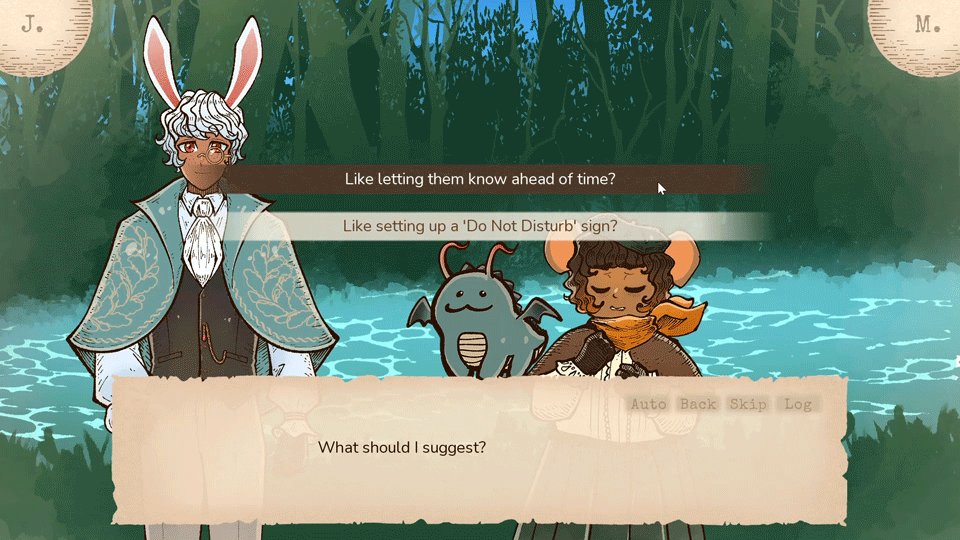
The final game is created with Ren'Py, an open-source visual novel engine.
Process
Pre-Production
Literature Review and Comparative Analysis
An initial search found that though gamification has been used in treating ADHD in children, most
digital
resources for adult ADHD take form as online courses, guidebooks, or podcasts. Meanwhile,
academic
papers support the idea that gamification encourages more engaged learning and patient
empowerment.
Thus, gamification and the adult ADHD lesson experience seemed like a perfect fit.
User Personas
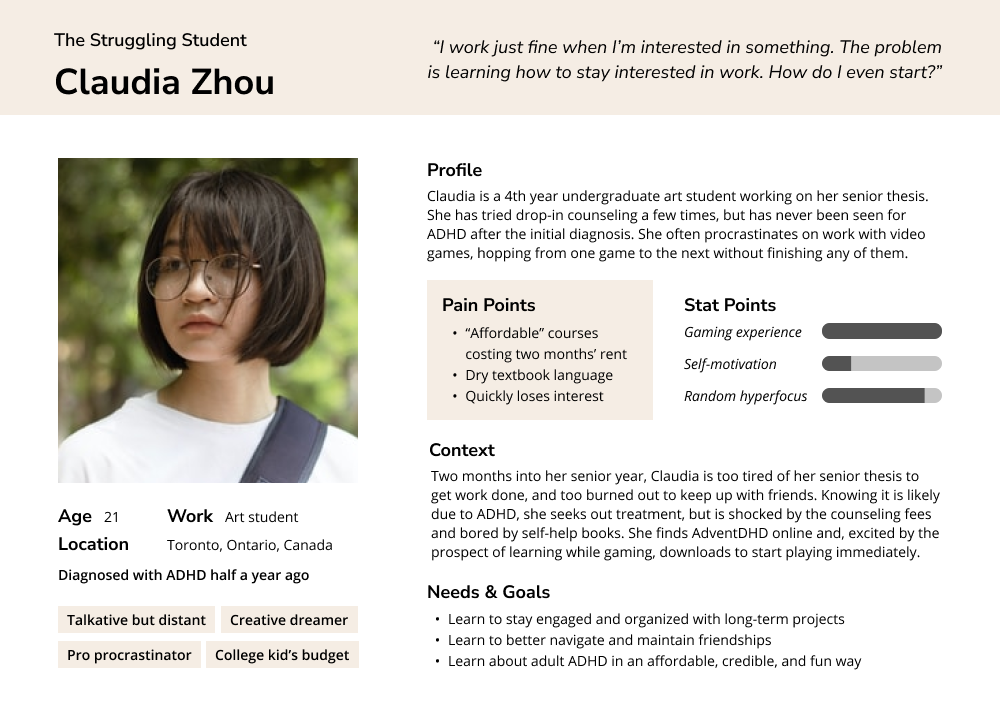
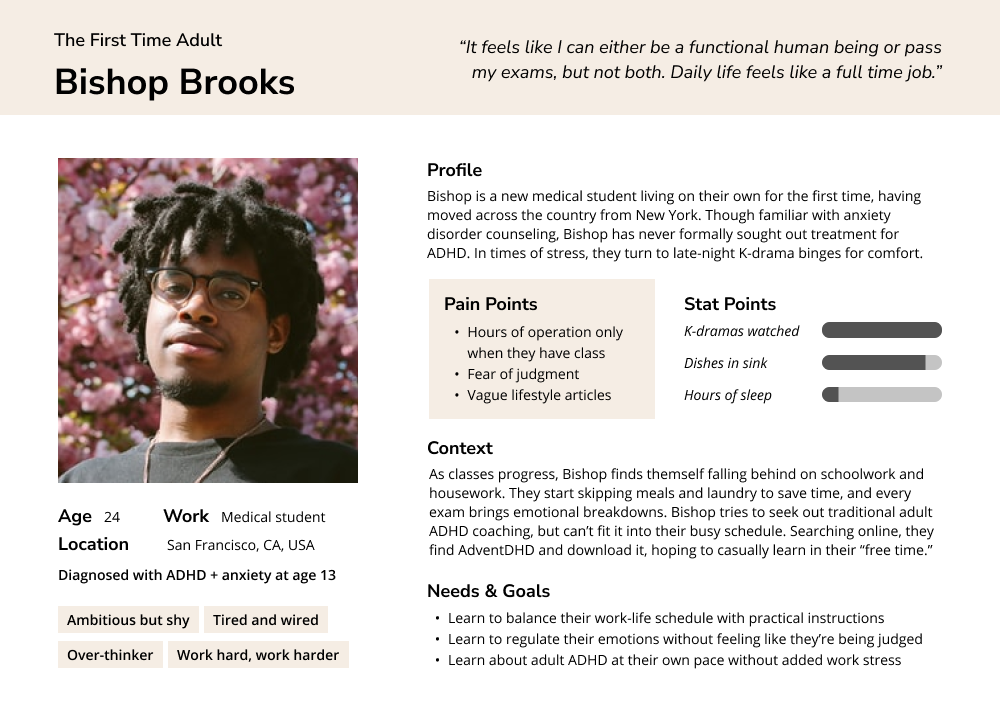
Content Research
Three resources were used as the basis for the content lessons of AdventDHD. I chose these resources based on the criteria that the techniques covered could be explained in actionable steps and used by the average young adult, without specialized equipment.
- The Adult ADHD Tool Kit: Using CBT to Facilitate Coping Inside and Out, by Anthony L. Rostain and J. Russell Ramsay
- Mastering Your Adult ADHD: A Cognitive-Behavioral Treatment Program, Therapist Guide, by Carol A. Perlman and Steven A. Safren
- Cognitive-Behavioural Therapy for ADHD in Adolescents and Adults: A Psychological Guide to Practice, by Jessica Bramham and Susan Young
Lesson content was reviewed by and edited according to feedback from a licensed psychiatrist specializing in ADHD.
Production
First Iteration: Initial Wireframe and Script
The narrative and lesson content were intertwined from the start.
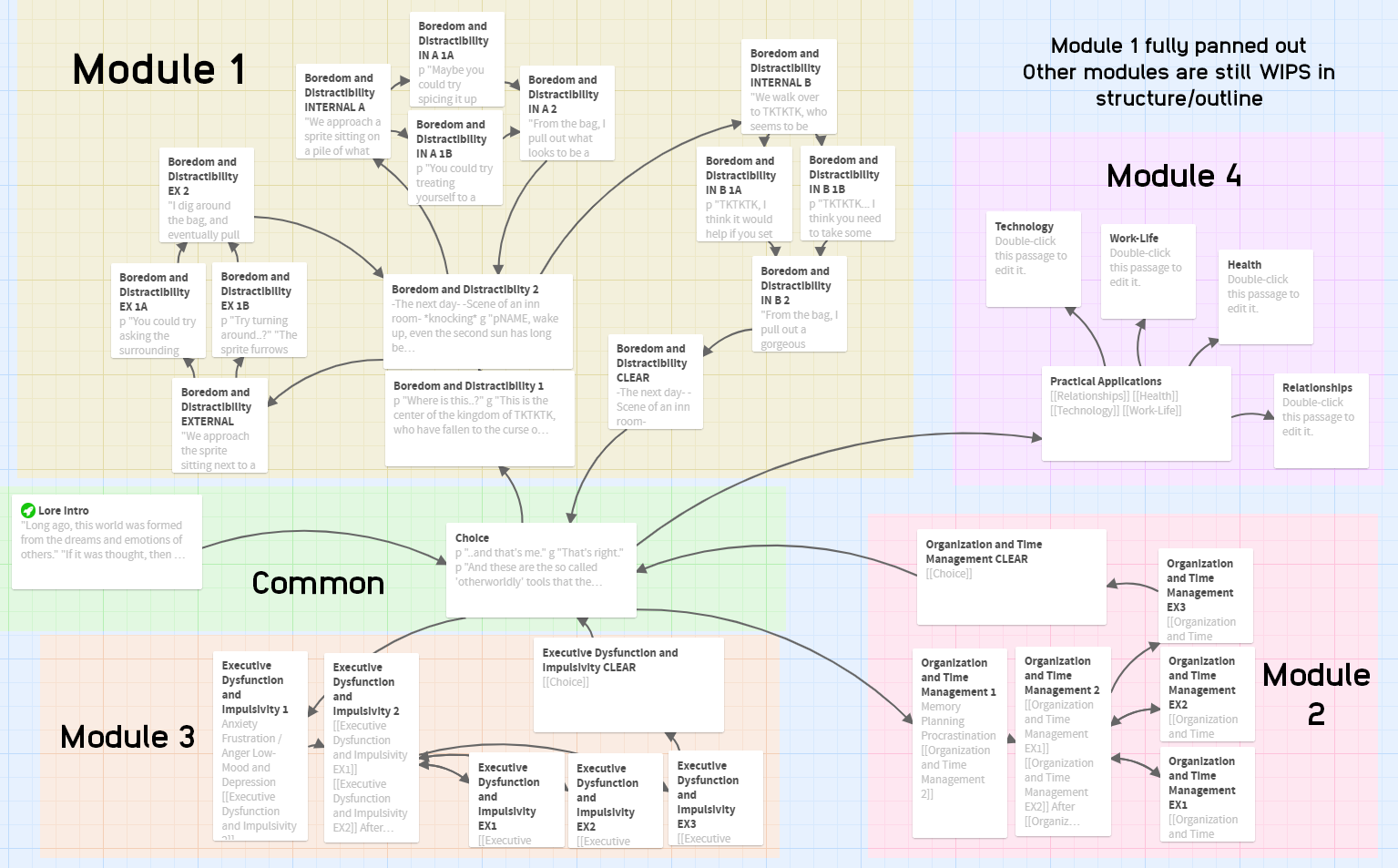
I planned the initial outline in Twine, an open-source tool for creating interactive text-based stories, which allowed for easier adjustments and notes on branching plotlines.
I originally split the content structure into four main modules covering major symptoms and impacts of ADHD, with each module taking place at a separate location in the fantasy setting:
- Boredom and distractibility
- Organization and time management
- Executive dysfunction and impulsitivity
- Practical applications of techniques in daily life
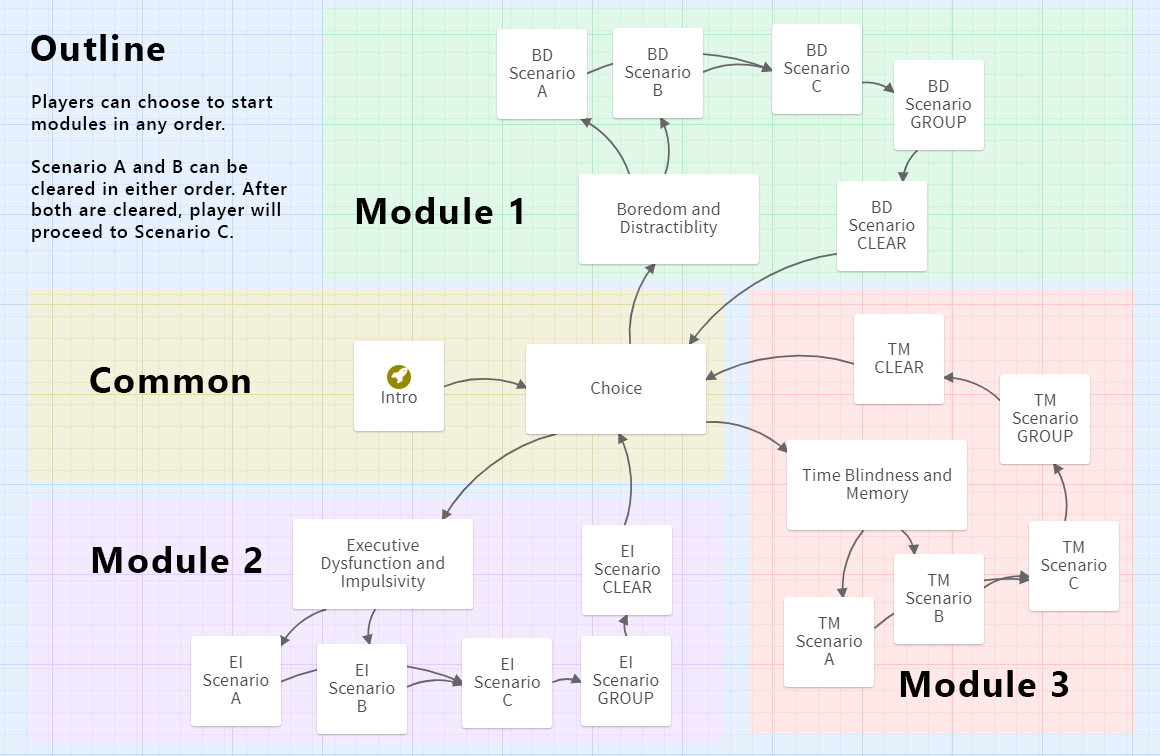
After drafting and receiving feedback on the initial script for Module 1, I merged Module 4 with the other modules. A topic such as "Relationships" can have many ways in which it's affected by ADHD. Rather than overwhelming players with all of those impacts and solutions at once, I chose to separate these lifestyle topics by symptom to help players get to the root of their problems.
Second Iteration: Theme Design and Initial Prototype
The main thematic inspiration was originally the popular "isekai" story trope found in anime and manga, in which the protaganist is transported to another world. The core concept of "mundane becomes fantastical" was present from the start.
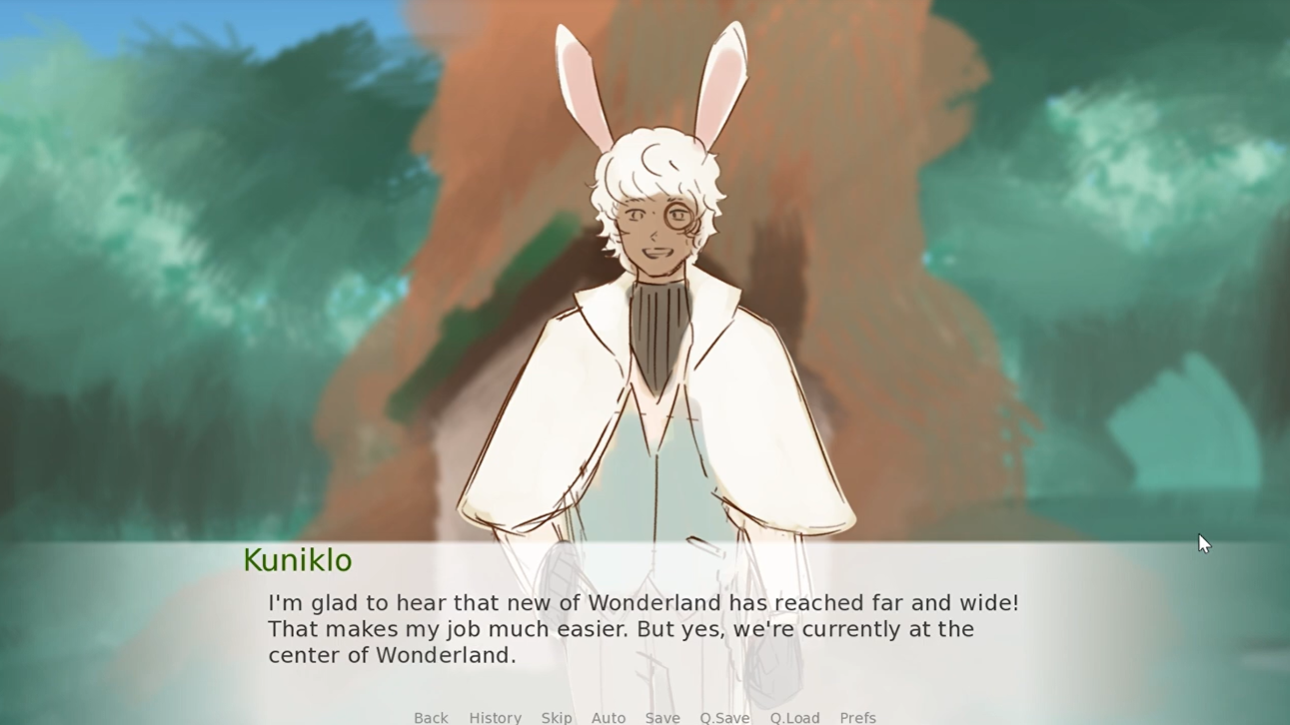
Lewis Carroll's "Alice's Adventures in Wonderland," an "isekai" story known around the world, was chosen as the main narrative inspiration. This welcomes more players into an intriguing yet familiar setting, easing up the onboarding content load.
Third Iteration: Narrative Expansion
Initially, players could visit any of the three modules from the start of the game. Along with the thematic overhaul, I adjusted the narrative and future programming plans so that players would have to first complete two specific modules before moving to the final module, to better scaffold the learning process.
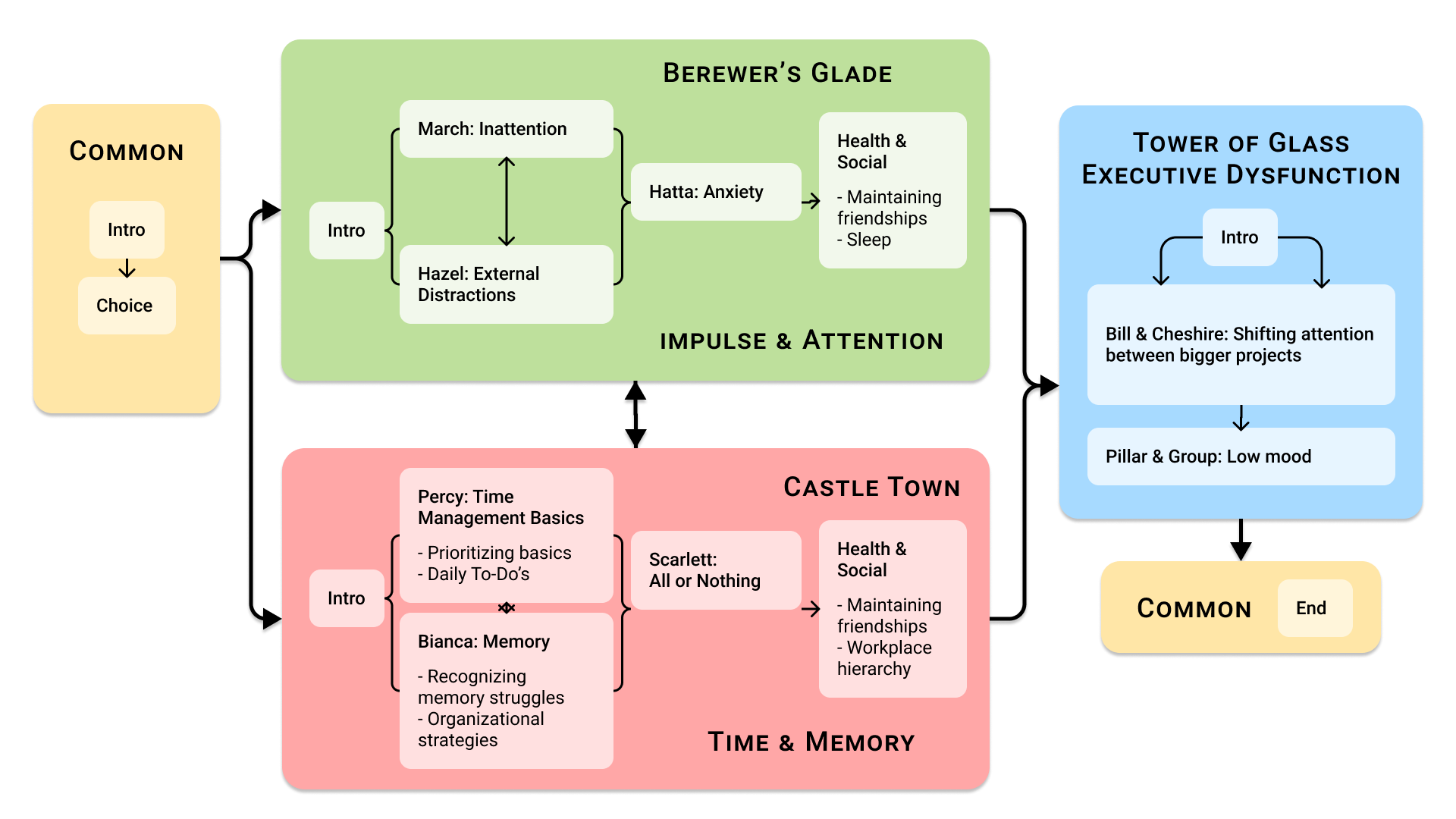
Visual Development
I chose a visual theme of "soft parchment and vivid inks" to emphasize the narrative setting. I wanted AdventDHD to be a friendly and welcoming experience, but still retain a more mature tone fitting for young adults by using detailed linework.
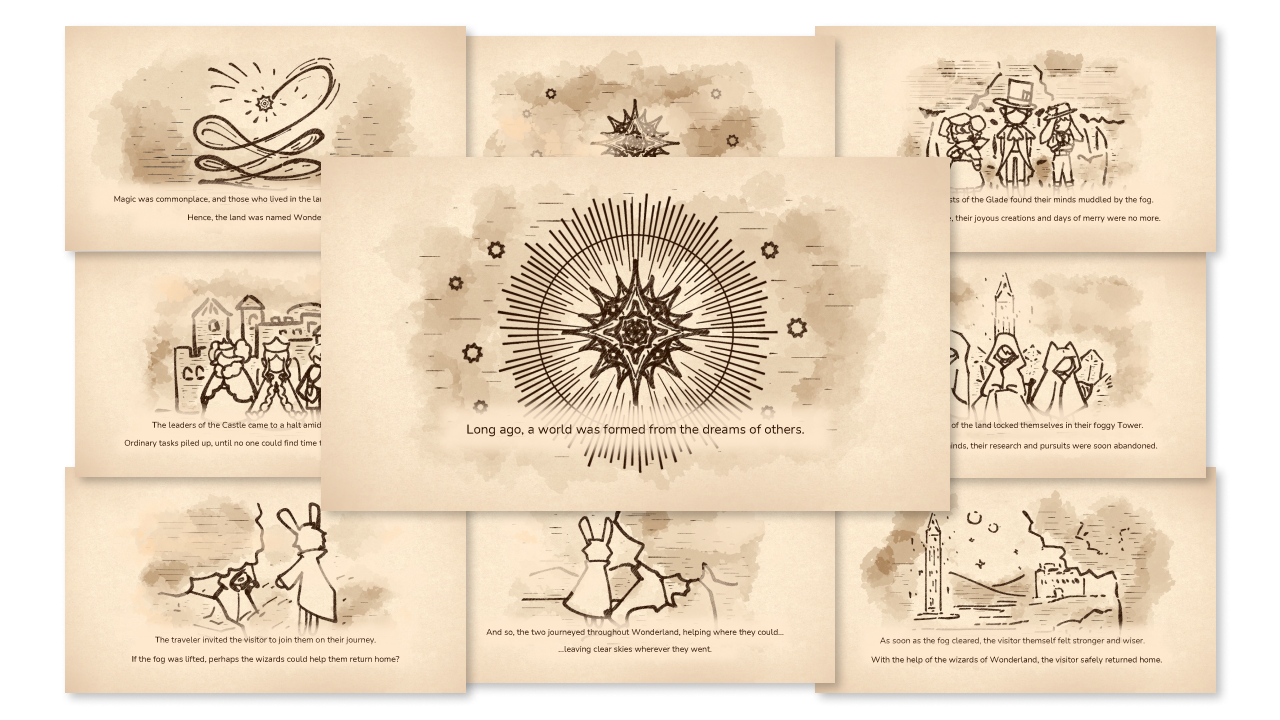
I styled the opening sequence like a nostalgic fairytale. This allowed me to quickly set up the narrative structure and move on to lesson content, without subjecting players to a wall of text upon starting the game.
The heavy linework used in the opening and in character sprites was inspired by medieval manuscripts. To further tie the character designs with the source inspiration, I took inspiration from 19th century British in addition to medieval fantasy fashion.
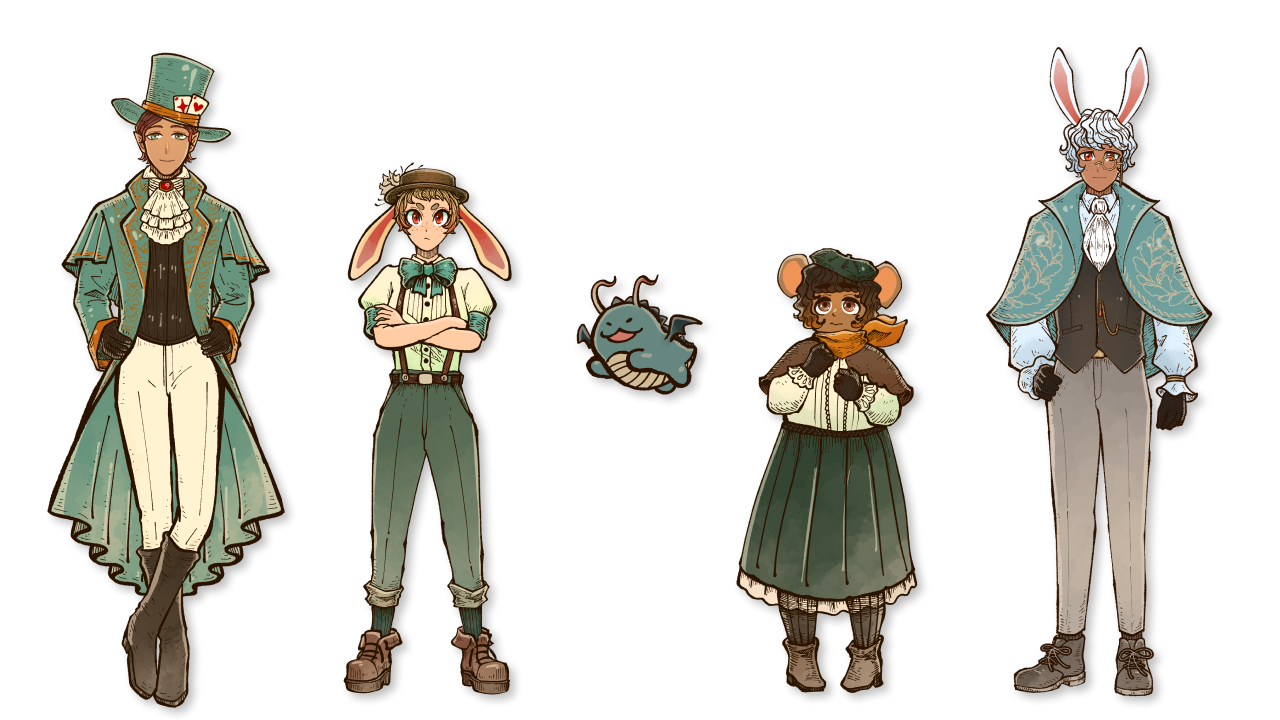
Characters were inspired by the original cast of Wonderland, as well as "Jabberwocky," a poem from the same author. Each character has a variety of expressions that change with the dialogue.
By choosing to help the characters, players can unlock full screen splash illustrations, encouraging them to play through the full lesson experience. A major goal of AdventDHD is for players to empathize with the characters as they learn alongside them. I chose to show the characters at their triumphant moments to both immerse and empower players.
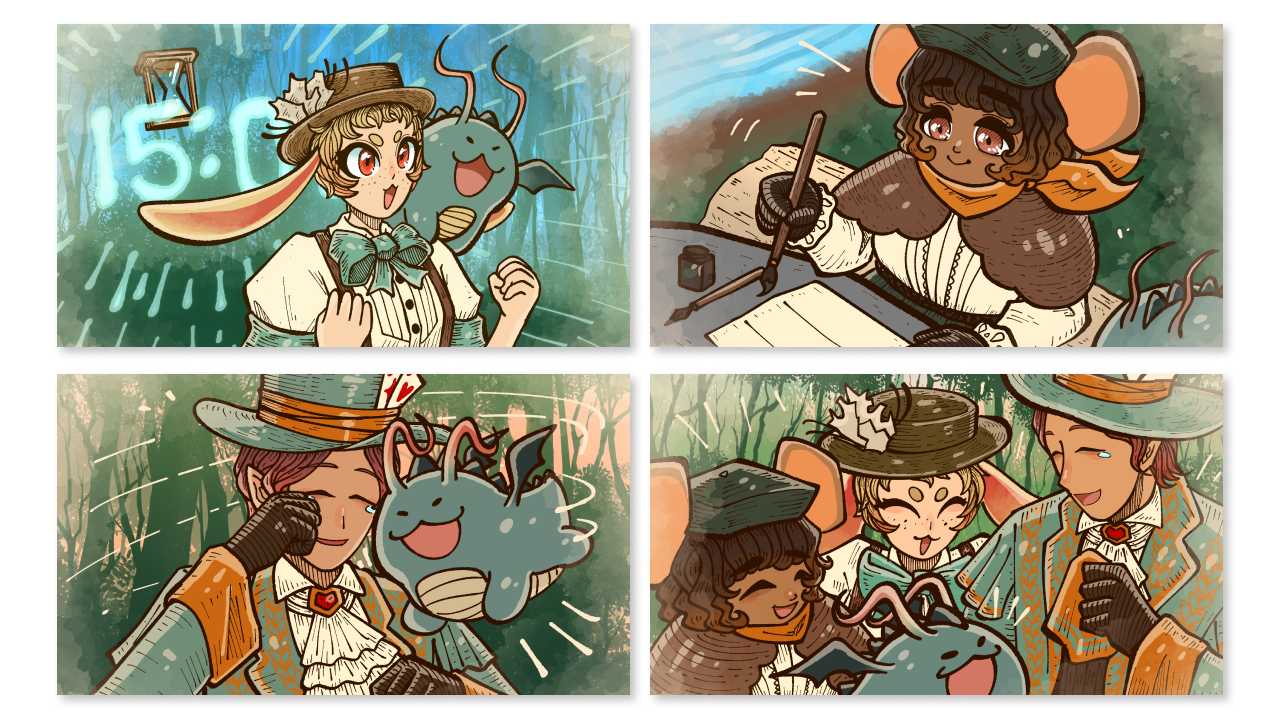
Each lesson has one unlockable splash illustration. For the first module, that's a total of four illustrations: one for each character, and one group shot.
Playable Prototype and Player Feedback
I distributed a short playable prototype featuring one lesson to players for initial informal feedback. Players did not report any complications in installing or running the game.
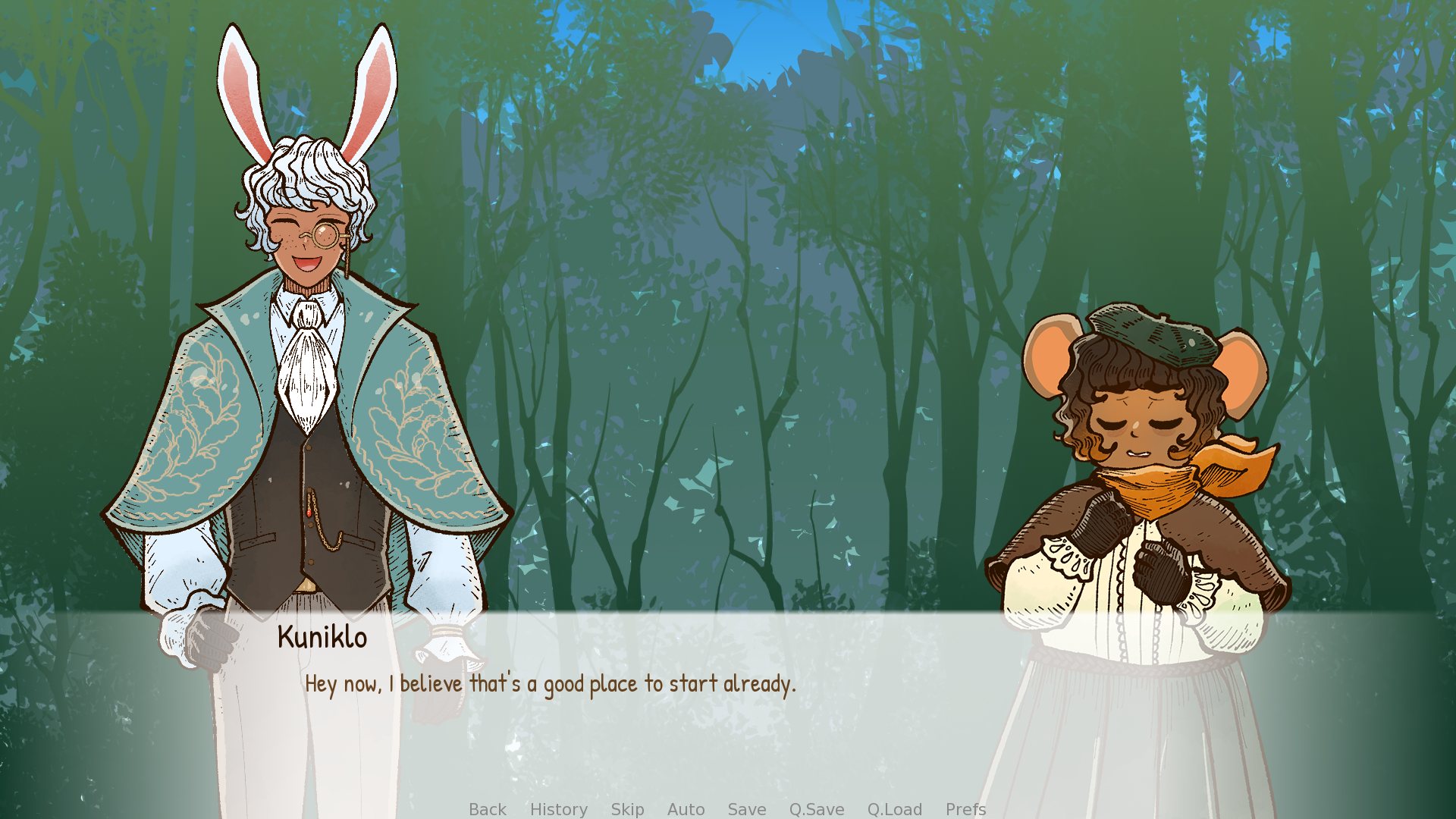
The main points of friction identified were as follows:
- Players with little to no prior visual novel experience struggled to keep track of changing character expressions while reading dialogue text.
- The differentiation of the player character's lines versus the dialogue of other characters was sometimes unclear.
Game UI Design
Following player feedback, I tested different text formats.
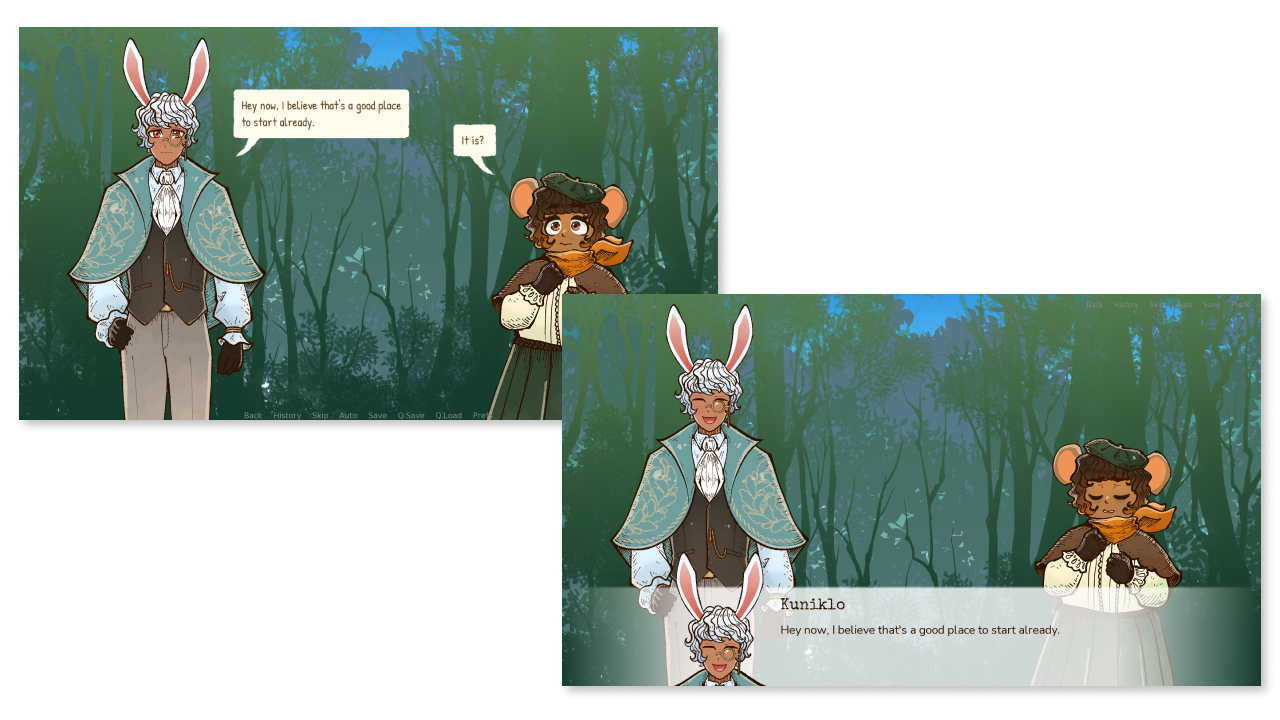
Speech bubbles and side portraits were tested out.
I chose to use a side portrait format for the following reasons:
- Character expressions could easily be seen within the same area of attention as text.
- Text would still remain stationary in one area of the screen.
- Though not as common as those without, there is a precedent for side portraits among existing visual novels, so players with prior experience would not find it jarring.
Furthermore, because the game takes place from the player's point of view, the player character does not have an in-game side portrait. Using this format, the lack of a side portrait helps differentiate player dialogue and narration from the rest.
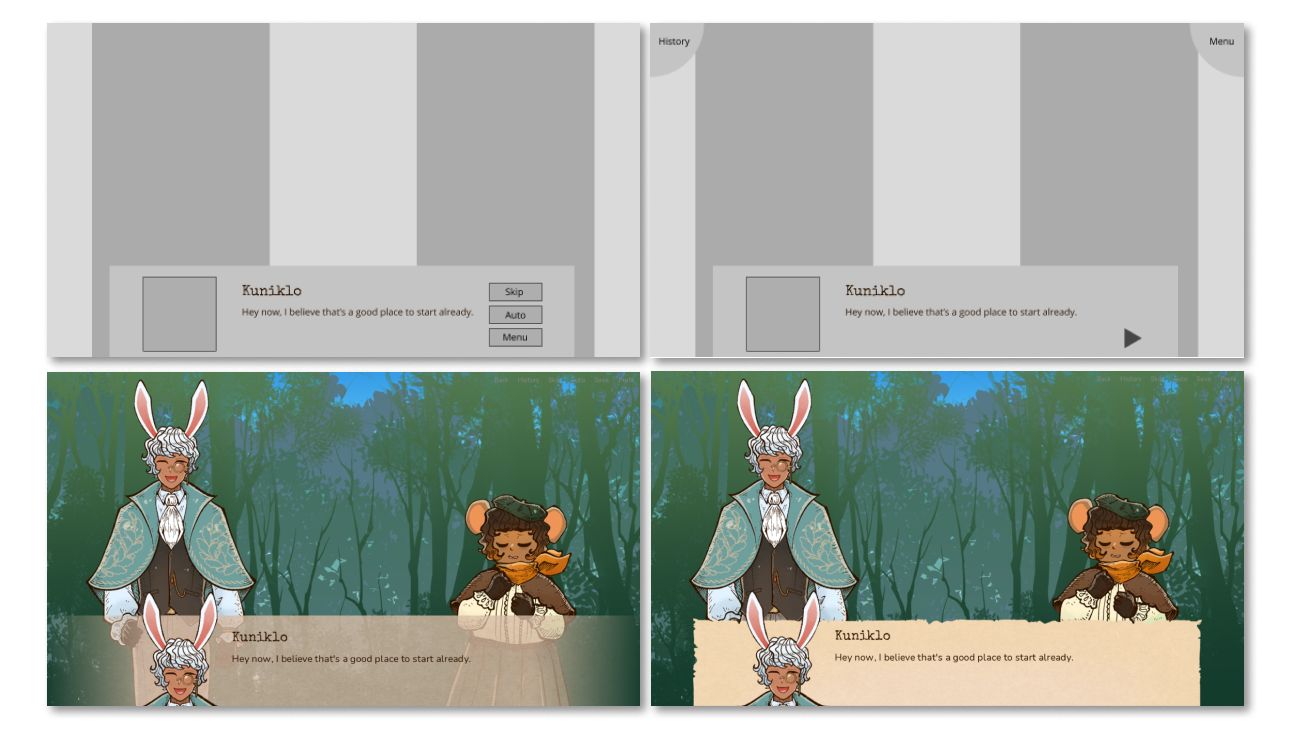
I created lo-fi mockups to test out different button placements. For purposes of time, I created higher fidelity mockups at the same time to compare different visual designs of the textbox.
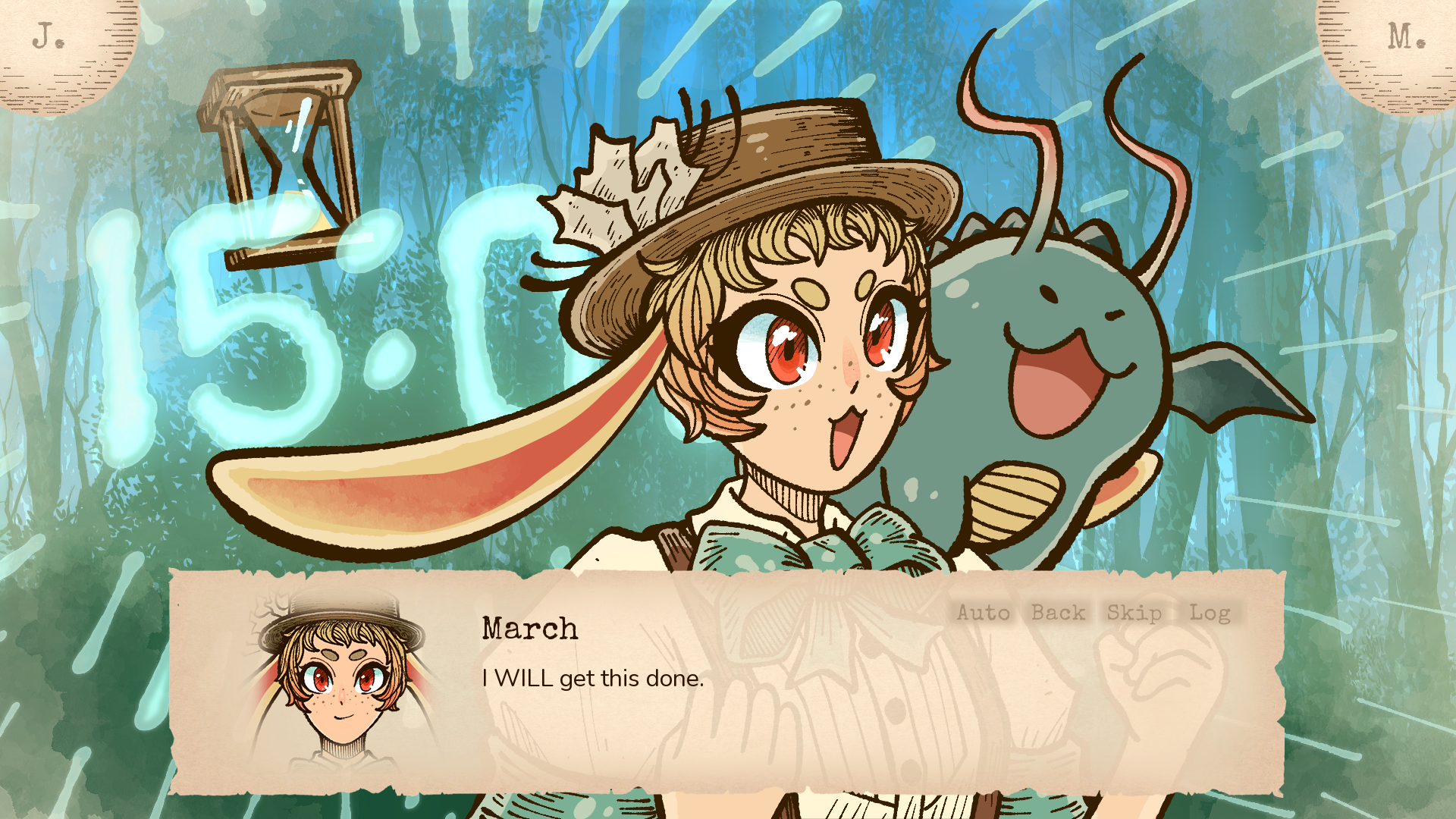
The final main interface design, featuring one of the unlockable full screen splash illustrations.
Conclusion
Next Steps
Continued research and script writing
Further scenarios to be written, to round off the hero's journey.
Further asset creation and implementation
More art to come, including more full-screen illustrations, characters, and backgrounds. Music and sound effects will be added in the final game.
In-game journal feature
An in-game journal will be added, allowing players to keep track of characters and review lesson information at a glance.
Awarded the 2021 Vesalian Scholar Grant
The Vesalius Trust for Visual Communication in the Health Sciences is a non-profit public foundation established to support education and research within the biocommunication field. The Vesalian Scholar Grant is awarded for exceptional merit in proposal design, production plan, and project concept, including potential contributions to biocommunication.
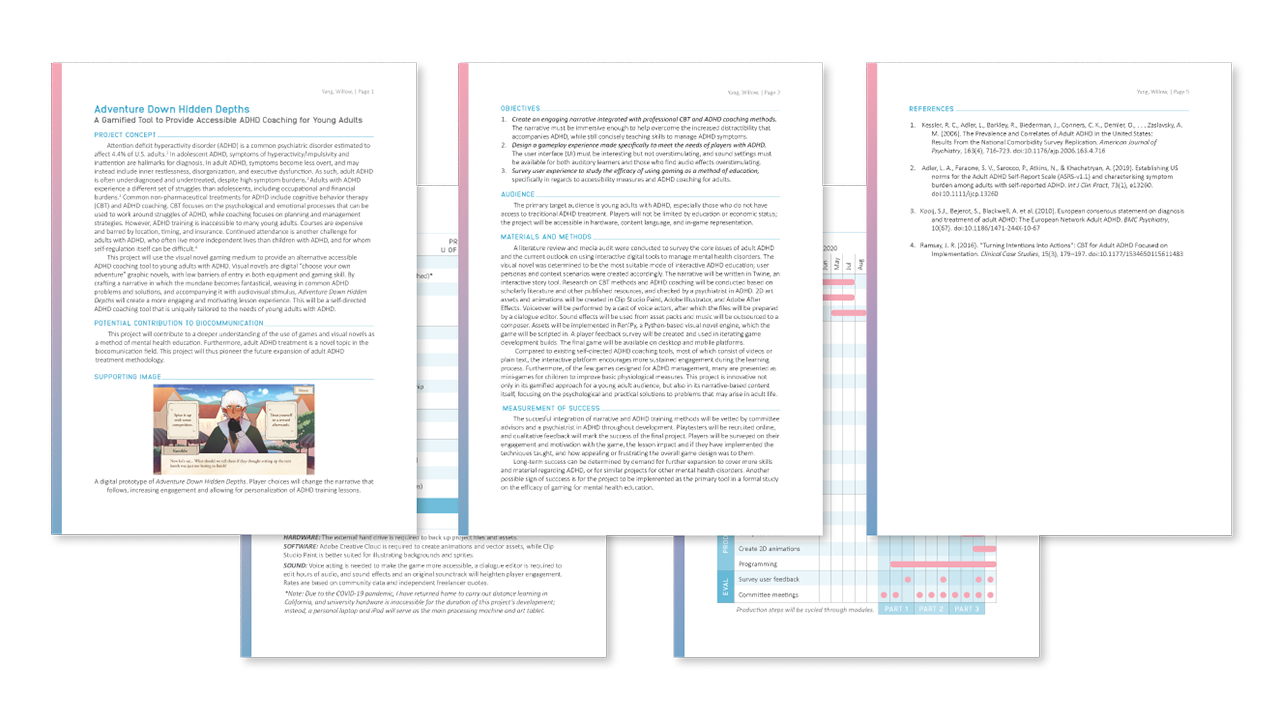
Reflections
AdventDHD is an ongoing project. It has been challenging to work on because of its multidisciplinary nature, but it has also the most interesting project I've had the chance to make real.
Check back Fall 2022 for final case study updates.
References
- Kessler, R. C., Adler, L., Barkley, R., Biederman, J., Conners, C. K., Demler, O., . . . Zaslavsky, A. M. (2006). The Prevalence and Correlates of Adult ADHD in the United States: Results From the National Comorbidity Survey Replication. American Journal of Psychiatry, 163(4), 716-723. doi:10.1176/ajp.2006.163.4.716
- Adler, L. A., Faraone, S. V., Sarocco, P., Atkins, N., & Khachatryan, A. (2019). Establishing US norms for the Adult ADHD Self-Report Scale (ASRS-v1.1) and characterising symptom burden among adults with self-reported ADHD. Int J Clin Pract, 73(1), e13260. doi:10.1111/ijcp.13260
- Ramsay, J. R. (2016). “Turning Intentions Into Actions”: CBT for Adult ADHD Focused on Implementation. Clinical Case Studies, 15(3), 179–197. doi:10.1177/1534650115611483
- Ramsay, J. R., Rostain, A. L., & Ramsay, J. R. (2015). The adult Adhd tool kit: using Cbt to facilitate coping inside and out. Routledge.
- Safren, S. A., Sprich, S. E., Perlman, C. A., & Otto, M. W. (2017). Mastering your adult Adhd: a cognitive-behavioral treatment program: therapist guide. Oxford University Press.
- Young, S., & Bramham, J. (2012). Cognitive-Behavioural Therapy for Adhd in Adolescents and Adults A Psychological Guide to Practice. Wiley.
